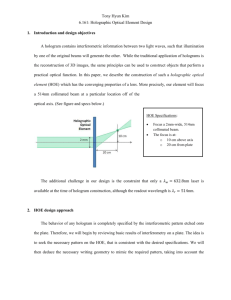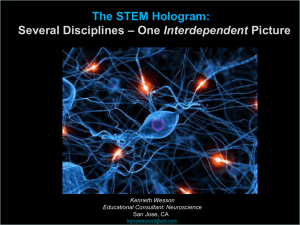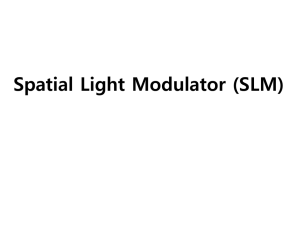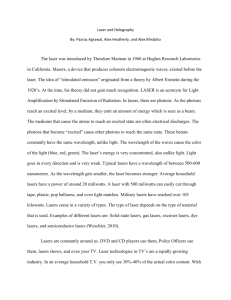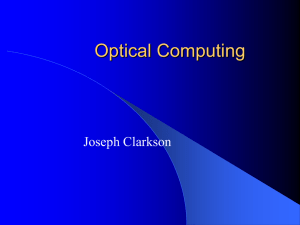Improved direct binary search-based algorithm for generating
advertisement
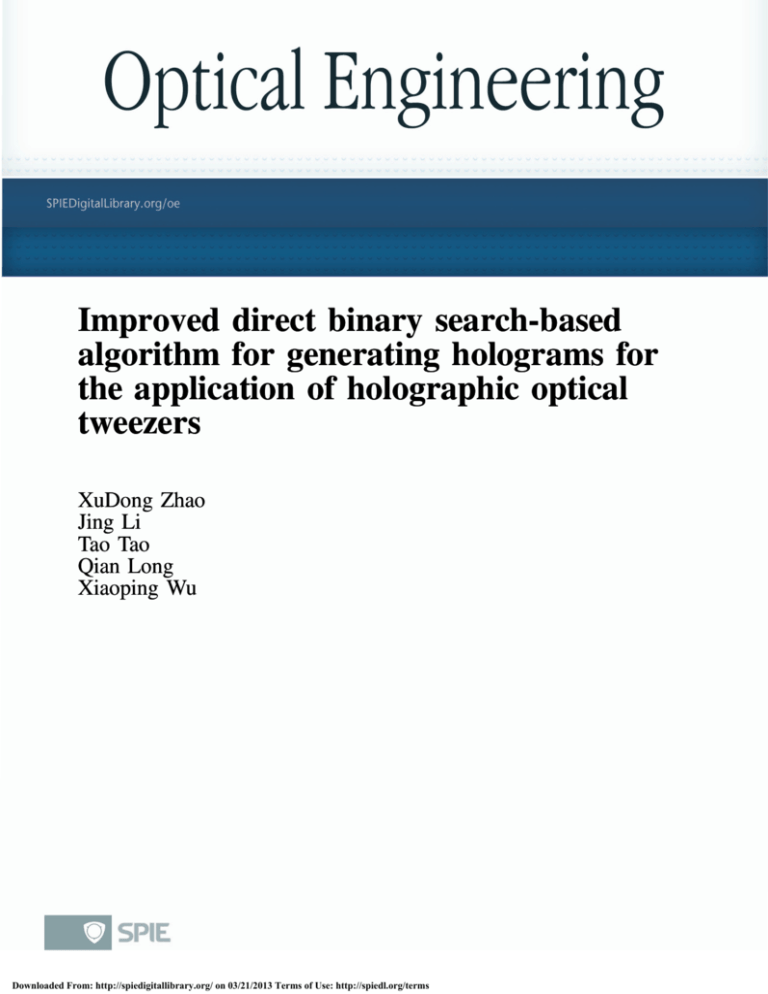
Improved direct binary search-based algorithm for generating holograms for the application of holographic optical tweezers XuDong Zhao Jing Li Tao Tao Qian Long Xiaoping Wu Downloaded From: http://spiedigitallibrary.org/ on 03/21/2013 Terms of Use: http://spiedl.org/terms Optical Engineering 51(1), 015801 (January 2012) Improved direct binary search-based algorithm for generating holograms for the application of holographic optical tweezers XuDong Zhao Jing Li Tao Tao Qian Long Xiaoping Wu University of Science and Technology of China College of Engineering Science Hefei, 230027, China E-mail: lijing@ustc.edu.cn Abstract. This paper presents an improved direct binary search (DBS)based algorithm for generating holograms to holographic optical tweezers. The simulations show that the improved algorithm greatly enhances computation speed while maintaining high hologram efficiency and highintensity homogeneous target spots. The improved algorithm was applied to generate holographic optical tweezers in several experiments. The experiments demonstrate that real-time trap and manipulation can be realized with the improved algorithm if the number of trapped microparticles is small. © 2012 Society of Photo-Optical Instrumentation Engineers (SPIE). [DOI: 10.1117/ 1.OE.51.1.015801] Subject terms: direct binary search; computer-generated holograms; spatial light modulator; holographic optical tweezers. Paper 110847 received Jul. 28, 2011; revised manuscript received Nov. 9, 2011; accepted for publication Nov. 11, 2011; published online Feb. 6, 2012. 1 Introduction Holographic optical tweezers could flexibly trap and manipulate particles, which play an important role in many fields such as physics, chemistry, life sciences, micro-and nanomanufacturing, and microfluidics.1–5 The key to a holographic optical tweezers system is the hologram's design. So far, Gerchberg-Saxton (GS), DBS (Direct Binary Search), and other algorithms have been developed.6–9 These algorithms need to be optically efficient and fast enough for real-time manipulation. DBS has excellent performance in terms of flexibility and output efficiency, but requires a great deal of computation time. The output plane phase optimize (OPPO) algorithm proposed by Georgiou et al.,10 is an alternative to DBS and very suitable for designing spot-generating holograms for the use in holographic optical tweezers. To create S-target spots on the output plane, the OPPO algorithm chooses randomly 4 − 5 S pixels from the hologram plane, and flip operations are only performed on the selected pixels in order to design a temporary hologram and form the target output plane (DBS is used in this step). Then, the phase of the output spots is measured, and the inverse DFT can be computed in order to obtain the full-resolution hologram. However, the computing speed of OPPO is still a drawback. Based on this research, we improved this algorithm to reduce its run time. The experiments on the improved OPPO were also performed on the holographic optical tweezers platform. presented. The improved algorithm consists of five main steps for generating S-target spots on the output plane. 1. Randomly choose S-pixels from the hologram plane. 2. Using the selected S-pixels, design a 2-phase-level temporary hologram by DBS to optimize the output plane. 3. Obtain the phase data of the target spots on the output plane. 4. Use FFT together with the phase of the output spots to calculate the full-resolution hologram and quantize its phase values to the nearest 1∕p (p is the number of the SLM’s phase levels). 5. Compute the efficiency of the hologram: if it is less than the cut-off value (we set it to 80%), go to the first step and recalculate a new hologram. It should be noted that in the second step of the improved algorithm, we use inverse fast Fourier transform (IFFT) in DBS to calculate the reconstruction (the output plane) and FFT in the fourth step to calculate the full-resolution hologram. This setting is the reverse of the original OPPO but the same as the classic DBS algorithm,6,7 which does not affect the algorithm’s effectiveness since the hologram plane and the output plane still keep their Fourier transform relationship. 3 Calculations 2 Improved Algorithm In the holographic optical tweezers system, the hologram plane and the output plane (i.e., the focal plane of the objective lens) are related by the Fourier transform. Based on the OPPO algorithm mentioned in Ref. 10, some improvements focused on temporary pixels and phase levels will be 0091-3286/2012/$25.00 © 2012 SPIE Optical Engineering 3.1 Effect of Temporary Phase Levels During the optimization of the temporary hologram, random flip operations are performed on the phase of the pixels, and the effectiveness of the flips is observed through the cost function. When the cost function is minimized, the output spots’ phase is considered optimum. In the second step of OPPO, the number of the temporary hologram’s phase levels is usually equal to the SLM’s. If the 015801-1 Downloaded From: http://spiedigitallibrary.org/ on 03/21/2013 Terms of Use: http://spiedl.org/terms January 2012/Vol. 51(1) Zhao et al.: Improved direct binary search-based algorithm for generating holograms : : : Table 1 Phase level and the phases of the output spots. 2π 256 Phase division 2π 128 2π 64 2π 32 2π 16 2π 8 2π 4 2π 2 Spot 1’s phase 0.3182 0.3184 0.3174 0.3186 0.3193 0.3193 0.3164 0.3237 Spot 2’s phase 2.5258 2.5270 2.5260 2.5251 2.5263 2.5275 2.5350 2.4319 Spot 3’s phase −0.7367 −0.7351 −0.7358 −0.7379 −0.7404 −0.7253 −0.7571 −0.7663 Spot 4’s phase −0.4613 −0.4612 −0.4613 −0.4591 −0.4624 −0.4633 −0.4619 −0.4740 Run time(s) 35.63 18.03 9.28 5.06 2.89 1.88 1.36 1.16 80.91% 80.91% 80.91% 80.91% 80.91% 80.91% 80.91% 80.91% 3.9562 3.8125 4.0259 4.2349 5.1002 6.9409 5.5849 3.7743 Efficiency Intensity mean square error ð 10−5 Þ number of SLM’s phase levels is p, the flip operation should be performed p times, so should be the inverse Fourier transform, which is used to calculate the reconstruction and determine the effectiveness of the flips through the cost function. Generally, p is no less than 8, which means a lot of flip operations are needed per iteration. This requires a large amount of time. The improved algorithm only uses two phase levels, which means that the temporary pixels have two phase values, 0 and π. We found that the algorithm is still effective even though the phase levels of the temporary hologram were reduced. The simulation results will be given to support this point below. Here, the Matlab programming language was used to simulate the algorithm (calculations were performed on a computer with an Intel dual-Core 2.50 GHz processor) for a 4-spot-generating hologram with 256 × 256 pixels. Sixteen temporary pixels were chosen randomly to form the temporary hologram. The cost function presented in Ref. 10 was also used in this improved algorithm. The positions of the temporary pixels and the initial hologram were kept the same in every simulation. Table 1 shows the phase of the 4 target spots (as radian), the program’s run time, and the hologram efficiency, showing that the phase levels of the temporary hologram decreased from 256 to 2. The last row of the table gives the intensity mean square error (IMSE) of the four output spots. In Table 1, the hologram efficiency is defined as PS i¼1 pi ; (1) η ¼ PM×N j¼1 pj where pi is the power of the output spots, pj is the power of the whole output plane, and M × N is the total number of output plane pixels. It can be seen that the optimum phase of the target spots obtained by the 2-phase-level hologram is different from the 256-phase-level hologram, but their efficiency and IMSE are almost the same. Meanwhile, the computation time decreased from 35.63 s to 1.16 s. Furthermore, we computed hundreds of holograms in order to generate different numbers of spots with different positions, and the results still support our point. It can be concluded that even with the simplest binary hologram, which has only two phase levels, the optimum phase on the output plane exists. So, it is unnecessary to set the phase levels of the temporary hologram to be equal to the SLM’s. In addition, during hologram calculation, the pixels were only iterated once. Because the optimum phase of the output plane is decided after a single iteration, the results derived from additional iterations have no effect compared with those from the first iteration. The simulation results also support this claim. Taking the 2-phase-level hologram in Table1, for instance, the output spots’ phase did not change after 2 to 5 iterations compared with the first iteration, as shown in Table 2. Therefore, during the calculations, two phase levels and one iteration were used. 3.2 Effect of the Temporary Pixels’ Number On the basis of cutting down the number of the temporary phase levels, and in order to reduce the computing time further, the possibility of reducing the temporary pixels' number will be discussed next. A spot-generating hologram can be expressed as shown below:10 Table 2 Iteration times and the phases of the output spots. hðx; yÞ Iteration times 1 time 2 times 3 times 4 times 5 times Spot 1 0.3237 0.3237 0.3237 0.3237 0.3237 Spot 2 2.4319 2.4319 2.4319 2.4319 2.4319 Spot 3 −0.7663 −0.7663 −0.7663 −0.7663 −0.7663 Spot 4 −0.4740 −0.4740 −0.4740 −0.4740 −0.4740 Optical Engineering ¼ ejΦ1 e−jðu1 xþv1 yÞ þ ejΦ2 e−jðu2 xþv2 yÞ þ : : : ejΦS e−jðuS xþvS yÞ ; jejΦ1 e−jðu1 xþv1 yÞ þ ejΦ2 e−jðu2 xþv2 yÞ þ : : : ejΦS e−jðuS xþvS yÞ j (2) where x and y are the coordinates on the hologram plane, ui and vi are the coordinates of the i’th spot on the reconstruction plane, hðx; yÞ is the phase-only hologram, and Φi is optimum phase of i’th target spots. 015801-2 Downloaded From: http://spiedigitallibrary.org/ on 03/21/2013 Terms of Use: http://spiedl.org/terms January 2012/Vol. 51(1) Zhao et al.: Improved direct binary search-based algorithm for generating holograms : : : According to Eq. (2), in order to generate S-target spots, at least S-temporary pixels are needed. The OPPO algorithm requests choosing the pixels randomly in order to ensure that both the high and low frequencies are represented.10 This criterion was preserved in the improved algorithm. OPPO also needs the temporary pixels to be 4 to 5 times greater than the target spots. This principle is used to ensure fairness between spots and fair representation of the hologram’s surface, especially when there are two or a small number of target spots.10 But, in our research, the hologram efficiency is the more important factor that needs to be considered. It was found that the generated holograms may have a low efficiency when creating regular positioned target spots using S-temporary pixels in simulation. To avoid this situation, a judgment criterion was added to the program as the step 5 in Sec. 2. The cut-off value of the hologram efficiency, η, is set to determine whether recalculations are needed once the resulting hologram is produced. The program reselects another group of temporary pixels randomly and recalculates the hologram until its efficiency reaches a satisfactory value (e.g., 80%). After many simulations, we found that the hologram only needed to be recalculated once, at most, in order to achieve a high efficiency. It should be noted that if the target spots are irregularly (or randomly) positioned, the hologram efficiency keeps high and the recalculation step can be skipped. The judgment criterion is only used for ensuring high hologram efficiency, if necessary. In the simulations, we calculated holograms with 256 × 256 pixels, and the number of temporary phase levels was 2. The number of the randomly positioned S-target spots was 1 to 10, so the efficiency judgment criteria did not actually work. The hologram efficiency and the IMSE of the output spots when using S-temporary pixels are shown in Figs. 1(a) and 1(b) respectively. Figure 1 shows that the hologram efficiency is still higher than 80% when using randomly chosen S-temporary pixels, and IMSE of the reconstruction is on the order of 10−4 and can be ignored too. We conclude that decreasing the number of phase levels of a temporary hologram while reducing the number of temporary pixels results in a satisfactory hologram efficiency and the fairness between output spots. 3.3 Comparisons of the Computation Speeds Both the original OPPO algorithm and the improved algorithm were written in the Matlab language for comparing their computation speeds. In the calculations, the time required to flip and test a temporary pixel is t 1 , and the fourth step of the algorithm, which consists of one FFT calculation, phase rounding operation, and some other computations, takes t 0 . Therefore, the whole run time of the program will be t total ¼ p × St × t 1 þ t 0 ; (3) where St is the number of the temporary pixels, p is the number of the temporary hologram’s phase levels, and S-target spots will be created. Optical Engineering Fig. 1 Hologram efficiency (a) and IMSE of the output spots (b) using S-temporary pixels. Fig. 2 Holograms designed by the improved algorithm (a) and the original OPPO algorithm (b). For OPPO, St is 4S to 5S and p is equal to the number of SLM phase levels, while for the improved algorithm St is S and p is equal to 2. It is obvious that the improved algorithm greatly reduces the number of flip operations, which accelerates the computing speed. The holograms calculated by the improved algorithm showed good performance in terms of hologram efficiency and fairness between output spots, as shown in Sec. 3.2. A particular example of a 4-target-spot hologram with 256 × 256 pixels is shown in Fig. 2. The improved algorithm only required 0.8 s to achieve 80.91% efficiency. The original OPPO algorithm needed about 35 s to achieve the same efficiency using 16 temporary pixels and 256 phase levels. 4 Experiments In the holographic optical tweezers platform, a Nd:YAG solid-state laser with 1 W power operating at 532 nm was used as the light source. The holograms generated by the improved algorithm were put into the BNS PM512 phaseonly SLM (512 × 512 pixels, 256 phase levels), and the 015801-3 Downloaded From: http://spiedigitallibrary.org/ on 03/21/2013 Terms of Use: http://spiedl.org/terms January 2012/Vol. 51(1) Zhao et al.: Improved direct binary search-based algorithm for generating holograms : : : Fig. 3 Experimental setup of the holographic optical tweezers platform. mirrors M1 and M2 to meet the conditions specified by the manufacturer. The SLM modifies the phase of the incoming beam wavefront. A telescope was used to reduce the size of the modified beam to fill the entrance pupil of the objective lens and image the SLM onto the pupil plane. After passing through the telescope, the beam was reflected by a dichroic mirror, which was used to separate the laser beam and light of illuminator, and then focused into the sample plane using the high numerical aperture microscope objective lens. A CCD camera recorded the experiments. In these experiments, the positions of the target spots were determined using a mouse. Every updated operation was accomplished within 1 s. Figures 4(e)–4(g) are the recorded photos of eight trapped and controlled microparticles, and the corresponding 256gray-level holograms obtained by the improved algorithm are shown in Figs. 4(a)–4(d). 5 Conclusions By reducing the number of temporary phase levels to 2, choosing S (equal to the number of the target spots) temporary pixels with random positions, and using FFT, the calculation time required to generate a hologram was greatly reduced. The improved algorithm still performs well in terms of the hologram efficiency and fairness between the target spots. In addition, in order to avoid the low efficiency problem, the cut-off efficiency value was set to determine whether recalculations are needed. The experimental results demonstrate that real-time trap and manipulation of a small number of micro-particles can be accomplished with the improved algorithm. By utilizing high-performance computers, the program’s run time can be further shortened, which could make the real-time trap and manipulation of a large number of micro particles possible. Acknowledgments This work was financially supported by the National Natural Science Foundation of China (grant nos. 50975271 and 91023049). We thank Fred Firstbrook for his critical reading of this manuscript. References Fig. 4 (a)–(d) Eight-spot holograms; (e)–(h) photos of eight trapped and manipulated microparticles that were controlled by the corresponding holograms on the left to form different patterns. modulated laser beam was tightly focused using a 100 × NA1.25 Nikon oil-immersion microscope objective lens. Eight microparticles (made of polystyrene; diameter 2.5 μm) were trapped and manipulated. Figure 3 depicts the optical tweezers system used in the experiment. A linearly polarized laser beam was expanded and collimated by a beam expander. Before illuminating the phase-only SLM, the polarization direction and incident angle of the beam were adjusted by a half-wave plate and Optical Engineering 1. J. E. Molloy, K. Dholakia, and M. J. Padgett, “Preface: optical tweezers in a new light,” J. Modern Opt. 50(10), 1501–1507 (2003). 2. J. E. Curtis, B. A. Koss, and D. G. Grier, “Dynamic holographic optical tweezers,” Opt. Commun. 207(1–6), 169–175 (2002). 3. D. G. Grier, “A revolution in optical manipulation,” Nature 424, 810–816 (2003). 4. E. R. Dufresne et al, “Computer-generated holographic optical tweezer arrays,” Rev. Sci. Instrum. 72(3), 1810–1816 (2001). 5. M. P. MacDonald, G. Spalding, and K Dholakia, “Microfluidic sorting in an optical lattice,” Nature 426, 421 (2003). 6. M. A. Seldowitz, J. P. Allebach, and D. W. Sweeney, “Synthesis of digital holograms by direct binary search,” Appl. Opt. 26(14), 2788–2790 (1987). 7. J. H. Zhai, Y. Ruan, and Z. G. Li, “Binary phase computer-generated hologram synthesized by direct binary search algorithm,” OptoElectron. Eng. 22(6), 16–21 (1995). 8. T. Haist, M. Schkleber, and H. J. Tiziani, “Computer-generated holograms from 3D-objects written on twisted-nematic liquid crystal displays,” Opt. Commun. 140 (1997). 9. A. Kirk and T. Hall, “Design of binary computer generated holograms by simulated annealing: coding density and reconstruction error,” Opt. Commun. 94 (1992). 10. A. Georgiou, T. D. Wilkinson, N. Collings, and W. A. Crossland, “An algorithm for computing spot-generating holograms,” J. Opt. A: Pure Appl. Opt. 10, 015306 (2008). 015801-4 Downloaded From: http://spiedigitallibrary.org/ on 03/21/2013 Terms of Use: http://spiedl.org/terms January 2012/Vol. 51(1) Zhao et al.: Improved direct binary search-based algorithm for generating holograms : : : XuDong Zhao is pursuing her MS in mechanical engineering at the University of Science and Techonology of China. Her research interests are related to holographic optical tweezers and radially polarized light. Jing Li received her BS degree from Tongji University in 1991. She obtained her MS and PhD degrees from the University of Science and Technology of China (USTC) in 1998 and 2005, respectively. She is currently an associate professor at USTC. Her current research interests are holographic optical tweezers. Tao Tao is a PhD student in the Department of Precision Machinery and Precision Instrumentation at the University of Science and Technology of China. His research interests are in the field of optical trapping and manipulation. Optical Engineering Qian Long He received his BS in mechanical engineering and computer science from the University of Science and Technology of China in 2000. Thereafter, he obtained a PhD degree in precision instrument machinery from USTC in 2007. He was a visiting scientist at Brookhaven National Laboratory from 2009 to 2010 and a research associate at the University of Texas at Brownsville from 2010 to 2011. He is currently a faculty member at Department of Precision Machinery and Precision Instrumentation at USTC. His current research interests are data analysis and signal/image processing. Xiaoping Wu graduated from the Department of Mechanics of Peking University in 1960. She is currently a professor of mechanics of USTC and a member of the Chinese Academy of Sciences. During 1998 through 2003, she was vice chairperson of the Chinese Society of Theoretical and Applied Mechanics (CSTAM) and chairperson of the Chinese Society of Experimental Mechanics. Her specialized fields of study include photomechanics (holographic interferometry, speckle metrology, etc.), meso-mechanical experimentation (optics and synchrotron radiation) and mechanics in MEMS. 015801-5 Downloaded From: http://spiedigitallibrary.org/ on 03/21/2013 Terms of Use: http://spiedl.org/terms January 2012/Vol. 51(1)
